
The Montreal Gazette, February 26, 2003
Merck Frosst offers its scientists a voyage of exploration and discovery
By Warren Perley
 PHOTO: COURTESY OF MERCK FROSSTMerck Frosst is one of the country’s leading research-based pharmaceutical companies. Located in Kirkland, the site houses a world-class research centre, manufacturing and warehouse facilities, as well as administrative offices
PHOTO: COURTESY OF MERCK FROSSTMerck Frosst is one of the country’s leading research-based pharmaceutical companies. Located in Kirkland, the site houses a world-class research centre, manufacturing and warehouse facilities, as well as administrative officesOne line from a eulogy to the seven astronauts who perished aboard the Columbia space shuttle earlier this month keeps popping into my mind: “Above all, they were explorers,” Dick Cheney, the U.S. vice-president, said at a memorial service in Washington, D.C., shortly after the disaster.
The noun “explorers” is exactly what I had been thinking days earlier during a visit to the Merck Frosst Canada & Co. Kirkland plant, the oldest research-based pharmaceutical company in Canada and still one of the country's leaders in its field after more than 100 years.
The word “plant” does not do justice to the massive size and scope of the Merck Frosst facility. It is really a complex of connected sandstone buildings with storey-high vertical windows which hug the curves of the structures, affording panoramic views of the West Island off the Trans-Canada Highway, just west of St. John’s Blvd.

The complex houses the company’s main office with its sales and marketing arms, as well as a manufacturing plant and one of the top research facilities in the world, which operates under the name Merck Frosst Centre for Therapeutic Research. The research centre has specialized laboratories for medicinal and process chemistry, biochemistry, molecular biology, pharmacology and pharmaceutical research and development.
It’s like a scene out of a Star Trek movie - a self-contained entity like the Starship Enterprise with 1,900 employees, including 300 of the world’s leading scientific personnel. Among the many amenities on site are a cafeteria and dry-cleaning services, as well as a nearby bilingual day-care centre. Plans are under way for construction of a second day-care facility.
They have made breakthroughs in:While space-shuttle astronauts conduct scientific experiments in outer space, Merck Frosst scientists experience a parallel voyage of exploration and discovery in inner space.
 In 1899, Charles E. Frosst, a transplanted American, moved to Montreal and established Charles E. Frosst & Co
In 1899, Charles E. Frosst, a transplanted American, moved to Montreal and established Charles E. Frosst & CoPart of the company’s commitment to stimulating innovative research is to attract top talent. There is strong support for continuing education to allow staff to fulfill their potential. Programs are in place for courses and workshops, and there is financial assistance for approved outside training and educational leaves.
Discover and innovateAll such measures are intended to bolster staff in a quest to fulfill the mandate of founders Charles E. Frosst and George W. Merck to “discover and innovate.” For more than a century, the Merck and Frosst names have been involved in research to develop medicines to improve the quality of life.
They have made breakthroughs in:
- controlling the symptoms of asthma;
- the treatment of pain and inflammation;
- mitigating the effects of arthritis and glaucoma;
- cardiovascular diseases.
George W. Merck established a New York branch of his father’s German-based pharmaceutical company in 1891 and 20 years later started a Canadian branch in Montreal. Charles E. Frosst was a transplanted American who moved to Canada in 1892 and seven years later decided on Montreal as the site where he plunked down his $5,000 and founded the company which would bear his name.
Descended from a family whose ancestors arrived in New England shortly after the Mayflower, Frosst adopted Montreal as his home, married and had three sons and three daughters. All three sons, as well as a grandson, followed him into the business.
 Charles E. Frosst & Co. built a reputation across Canada with analgesics such as 217 and 222.
Charles E. Frosst & Co. built a reputation across Canada with analgesics such as 217 and 222.The two companies were gradually merged after Merck and Co., Inc. acquired Charles E. Frosst & Co. in 1965.
In the early 1900s, Frosst emphasized “the superior quality of the ingredients” used in his “elixirs and syrups.” In 1906, his company began selling Aspirin-brand acetylsalicylic acid (ASA) under licence from the German drugmaker Bayer.
In 1910, his scientists developed an analgesic that combined ASA with caffeine to treat headaches and muscle pain. They called it tablet 217 because it was the 217th item listed in the tablet section of his catalogue. A year later, they added codeine to create a more potent analgesic which became known as a 222.
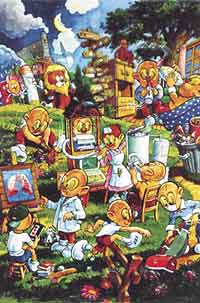 The Dingbat calendar was introduced in 1915 by Charles Frosst. Each year the Dingbats were featured performing scientific investigation or some collective effort of tending to patients.
The Dingbat calendar was introduced in 1915 by Charles Frosst. Each year the Dingbats were featured performing scientific investigation or some collective effort of tending to patients.His own best salesman, Frosst would bid his wife, Stella, goodbye on Sunday evenings and board a train for a destination in Ontario or Quebec where he would make his first sales call on a pharmacist or doctor at 8:30 Monday morning.
He wrote the advertising copy which appeared in newspapers and flyers himself. One of his earliest ads read: “When you specify Frosst for pharmaceuticals, you support Canadian industry and receive right quality for right prices.”
During the First World War, Frosst introduced what would become another icon - the Dingbat calendar which was distributed to doctors, pharmacists, hospitals and school nurses across the country. It featured a red-nosed, bug-eyed gnome-like character involved in an amusing experiment connected to medical research or hospital treatment.
Although the calendars were discontinued after 1993, the Dingbat art continued to be used on the annual compendium of pharmaceuticals and specialties published by the Canadian Pharmacists Association.

Being visible and active in the communities where it does business has always been part of the Merck Frosst mission. Part of that commitment is to support charitable and philanthropic organizations such as West Island Community Shares, United Way/Centraide and the Merck Frosst Employees Charity Trust Fund.
Strong support for students
One of the company’s strongest traditions has been its enduring support for young students interested in scientific pursuits. The firm awarded its first scholarship in 1900, only one year after Charles E. Frosst & Co. was incorporated in Montreal. To this day, the tradition continues with funding of a broad range of student scholarships, fellowships and other initiatives that reward and support excellence.
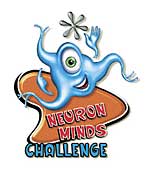 The Neuron Minds Challenge is one of the company’s recent science education initiatives.
The Neuron Minds Challenge is one of the company’s recent science education initiatives.The company’s involvement in elementary, secondary and university education entails more than financial support. A number of Merck Frosst scientists hold adjunct professorship positions in Canadian universities and supervise graduate students toward higher degrees. Company personnel regularly works with educators.
The emphasis on science education and recruitment of the world’s brightest minds is so important to Merck Frosst that it has a full-time manager, Christian Riel, who is in charge of those matters at the company’s Centre for Therapeutic Research.
Merck Frosst provides financial support to local, regional and national science fairs which are intended to recognize initiative and achievement in science experiments at the elementary and secondary school level.
 PHOTO: PHIL CARPENTERMerck Frosst’s Christian Riel and Agostino Porchetta of the English Montreal School Board collaborate on science education programs for students and teachers.
PHOTO: PHIL CARPENTERMerck Frosst’s Christian Riel and Agostino Porchetta of the English Montreal School Board collaborate on science education programs for students and teachers.During my recent visit, Riel arranged for me to meet Salvatore Mottillo, a Grade 11 student at Laurier Macdonald High School who won his first science prize as a 6-year-old in Grade 1 at Honoré Mercier School, now part of the English Montreal School Board. He was accompanied to the interview by Agostino Porchetta, a pedagogical consultant with the EMSB who has worked closely with Merck Frosst for many years in support of such science fairs.
Mottillo, whose mother is an English teacher, is clearly very bright. How many 16-year-olds do you know who have won a gold medal in a Canada-wide science fair for a project which involved “irradiating delayed brain tumour cells in a mouse.”
Every year since Grade 1, Mottillo has taken part in science fairs sponsored by Merck Frosst. His list of achievements is impressive:
- He was a Grade 1 prize winner for an experiment which involved testing the conductivity of metals.
- A 1998 experiment, titled To Clot or Not to Clot, dealt with various medications used to prevent blood clots.
- A 1999 experiment, titled Kidneys: Perfect Filters, gave an overview of kidney function and diseases. Mottillo built his own dialysis machine using tubes, Plexiglas and a wine pump. That project won him a gold medal and a McGill University biology award.
- His 2000 project, titled Crisis: Antibiotics Ineffective, won him another gold medal for talking about how bacterial phages can be used to attack antibiotic-resistant bacteria known as “superbugs.” Mottillo recalls that the project was "understandable, interesting and captivating.”
- His 2001 project was a follow-up, showing how bacteriophages can be more effective than antibiotics in dealing with bacteria. He was invited to present his results at the International Science and Engineering
- Fair in San Jose, Calif., where he won the Albert B. Sabin Vaccine Institute Award.
Is it any wonder that Merck Frosst has its eye on this young man? Mottillo, who says he hasn’t decided yet whether he wants to become a family doctor or a scientific researcher, was invited, along with some other promising science students, to visit the Merck Frosst laboratories two years ago.
He says he was struck by the physical immensity of the structure and its high-tech labs.
“I met scientists in the labs here,” he recalled. “They were really down to earth. They treated us almost like equals.”
Teachers are highly valuedStudents are not the only ones who receive special attention through the educational programs of Merck Frosst - teachers are also highly valued.
Porchetta, the EMSB’s pedagogical adviser, says his board’s collaboration with Merck Frosst dates to 1994, when they started an educational outreach program that helps teachers make the discovery of science, mathematics and technology meaningful and fun for elementary school students. As a result, science comes alive in the classroom.
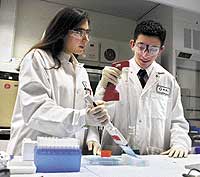 PHOTO: PHIL CARPENTERSalvatore Mottillo (right), a Grade 11 student at Laurier Macdonald High School, visits Myriam Salem, a former science fair prize winner who now works as a researcher at Merck Frosst.
PHOTO: PHIL CARPENTERSalvatore Mottillo (right), a Grade 11 student at Laurier Macdonald High School, visits Myriam Salem, a former science fair prize winner who now works as a researcher at Merck Frosst.One of the projects in the outreach program involved setting up a sleuthing exercise where teachers were presented with clues at a simulated crime scene and asked to perform science tests to try to find evidence of what had transpired. Another project was known as Science for Poets and involved integrating science concepts into language arts.
“Merck Frosst values the educators involved in these projects,” Porchetta said in an interview. “We’re able to attend workshops and have great exchanges with the scientists who work there.”
“Aside from its financial support for science fairs, Merck Frosst scientists also get involved as judges at some of the competitions,” Riel said. In fact, the head judge of all the science fairs in Quebec for almost 10 years has been Jacques-Yves Gauthier, a Merck Frosst researcher. Merck Frosst also donates to schools such equipment as computers and glassware for labs.
“If Merck Frosst weren’t there for us, bright students such as Salvatore would not have the opportunity to meet with young scientists from across Canada and the U.S.,” Porchetta said. “But with their help and resources, the doors are open.”
Riel says Merck Frosst’s science education program in Canada, which operates under the banner Exploring Minds, invests about $2 million annually. The company works with the various school boards in both the French and English sectors in order to foster interest in science and technology.
In Quebec, the company partners with the Conseil de développement du loisir scientifique, known by the abbreviation CDLS, which is responsible for organizing science fairs across the province.
In Ontario, the company sponsors a group known by the initials ACTUA, which runs science workshops in schools and organizes science summer camps.
“We’re driven by science, passion and discovery,” Riel said. “As a member of the community, we want to contribute in the area of science. As part of an information-based society, the future of our success in Quebec and Canada is linked to the success of the new generation of scientists.”
Canada ranks No. 14 among the 30-member countries of the Organization for Economic Co-operation and Development in terms of research and development. The country will need about 100,000 new scientists in the next 10 years if it hopes to get closer to the top - perhaps as high as No. 5.
To reach that level, between 30,000 and 40,000 new professors will be needed between now and 2011 due to the number of science teachers who will be retiring across Canada, increased student enrolment and additional needs in university R&D, according to an October 2002 report by the Association of Universities and Colleges of Canada.
Classroom to laboratoryAs part of its recruitment program, there is a co-op program for BSc students to work in the Merck Frosst labs under the supervision of world renowned scientists. Merck Frosst actively recruits students once they have completed their MSc, PhD or post-doctoral training.
Myriam Salem came to the company’s attention in much the same manner as high-school student Motillo. While studying for her MSc in biochemistry at Université de Montréal, she won a prize at a Pharmacology Day competition sponsored by the company.
In 2001, she got a job explaining science to children using a 3-D animation at a Merck Frosst science fair kiosk, which led to her later being hired to research anti-inflammatories, which involves screening blood compounds and finding new assays.
“I’m living the moment,” she said in an interview. “I want to learn new things. I’ll never reach the point of having nothing more to discover. It’s always a challenge.”
“Discovering today for a better tomorrow,” is more than the Merck Frosst motto. For Salem, it is the prospect and challenge of being part of a research team which could make a new discovery to help those suffering from medical conditions.
 PHOTO: COURTESY OF MERCK FROSST Dr. Kathleen Metters, vice-president of the Merck Frosst Centre for Therapeutic Research: “We want to make a difference in the lives of patients.”
PHOTO: COURTESY OF MERCK FROSST Dr. Kathleen Metters, vice-president of the Merck Frosst Centre for Therapeutic Research: “We want to make a difference in the lives of patients.”The head of her division, Dr. Kathleen Metters, vice-president of the Merck Frosst Centre for Therapeutic Research, knows what it feels like to play an instrumental role in the discovery of new treatments. In the Kirkland labs, she played a hands-on role in the discovery of Singulair®, approved by Health Canada in the late 1990s, for the treatment of asthma.
The story behind the discovery of Singulair® to treat asthma illustrates the important role played by Merck Frosst researchers.
Asthma is an increasingly serious health problem throughout the industrialized world, including Canada where 10 to 15 per cent of Canadian children and 6.4 per cent of adults are asthmatic. Asthma is the leading cause of hospital admission for children.
The Singulair® story also illustrates the time frame and resources needed to develop a new medication. It took 19 years of research and experimentation, hundreds of millions of dollars, the skills of more than 100 scientists at the Merck Frosst Centre for Therapeutic Research, and the screening of approximately 14,000 compounds before one was found which could safely block leukotrienes, which are molecular substances that trigger asthmatic reactions. Although the pace of drug discovery has accelerated, the commitment to excellence remains the same.
Merck Frosst researchers also discovered Vioxx®, which was launched in Canada in 1999.
What sets Vioxx® apart, according to Metters, is that it is a new generation of selective non-steroidal anti-inflammatories which can provide pain relief from osteoarthritis without blocking production of protective enzymes that produce prostaglandins, which are critical in protecting the lining of the stomach.
Both Singulair® and Vioxx® were cited in the 2001 annual report of parent company Merck & Co., Inc. of Whitehouse Station, N.J., as being among the five key company medicines, together with Zocor® for cholesterol reduction, Cozaar®/Hyzaar® for high blood pressure, and Fosamax® for the treatment of osteoporosis.
“Pharmaceutical research is the key to the discovery of medicines that will help treat the many diseases for which there are currently few or no treatment options available,” Metters said. “We want to make a difference in the lives of patients.”
The company backs up its high aspirations with an annual investment of nearly $120 million for research and development in Canada.
“As researchers, we try to understand the molecular mechanism of the disease and see whether we can intervene medically,” she said. “We pride ourselves on doing novel research at Merck Frosst and aim to be best in class. Our researchers are currently working on new treatments for inflammation, osteoporosis, chronic obstructive pulmonary disease and diabetes, to name a few.
In-house manufacturingIn addition to its research facilities, Merck Frosst is one of the few pharmaceutical companies in Canada to have an in-house manufacturing capacity.
Stan Booth, director of Manufacturing Supply Chain, says the Merck Frosst facility produces 1.2 billion tablets per year, of which 80 per cent are exported. Another 25 million units in bottles, blister packs or vials are produced annually, of which 10 per cent is exported. Most exports - tablets and units - go to the U.S.
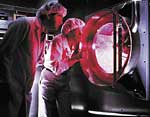 PHOTO: COURTESY OF MERCK FROSST
Jean-Pierre Lavictoire and Michel Crépeau monitor the action of the Accela-Cota tablet-coating machine.
PHOTO: COURTESY OF MERCK FROSST
Jean-Pierre Lavictoire and Michel Crépeau monitor the action of the Accela-Cota tablet-coating machine.Among the products manufactured at the plant are anti-hypertension medications Vasotec®, Vaseretic®, Prinivil® and Prinzide®. Mevacor® and Zocor® for cholesterol reduction are also made there. The manufacturing facility has been approved by Canadian, U.S. and European regulatory agencies.
“Our packaging volumes have doubled in the last five years because of higher domestic sales and exports to the U.S.,” Booth said.
The good news coming out of all the Canadian divisions has president André Marcheterre smiling these days. “Our mission is to be recognized as the best pharmaceutical company in Canada in terms of our quality of research and medicines,” he said in an interview in his Kirkland office.
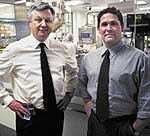 PHOTO: PHIL CARPENTERMerck Frosst president André Marcheterre (left) seen in the company’s manufacturing facility with Stan Booth, director, Manufacturing Supply chain.
PHOTO: PHIL CARPENTERMerck Frosst president André Marcheterre (left) seen in the company’s manufacturing facility with Stan Booth, director, Manufacturing Supply chain.Marcheterre says Merck Frosst sees itself as a partner with government, academia and health-care providers, sharing the goal of providing the best possible health care to all at the lowest possible cost.
The company believes in demonstrating the value of its medicines. As part of that commitment, Merck Frosst is involved with hospitals and provincial governments in disease-management initiatives which analyze health-care practices, costs and health outcomes. The objective is to analyze data to standardize the best practices using evidence-based medicine.
“The government spends about $16 billion a year in health care in Quebec, which is about 40 or 45 per cent of the total budget of the province, but we don’t have a base of evidence to assess whether we are getting the best possible outcome in a cost-effective way,” he said.
Cornerstone of successIf there is one area that is of paramount importance to a pharmaceutical company, it is the quality of its research and development personnel who are on the cutting edge of science.
Marcheterre ends the interview with comments which definitely remind me of Star Trek’s Capt. Jean-Luc Picard: “We put a strong emphasis on leadership. We encourage employees to question the status quo, to keep looking for a better way. Take risks, make mistakes, but take decisions which will lead to new approaches and new discoveries.”
In the Star Trek vernacular: “Boldly go where no one has gone before!”
COZAAR®/HYZAAR® Registered trademarks of E.I. du Pont de Nemours, Wilmington, Del., used under licence. ®Registered trademarks of Merck & Co., Inc. Used under licence.W
Warren Perley, a former career journalist, is president of Ponctuation Grafix, a marketing and graphic design studio (www.ponctuation.com).